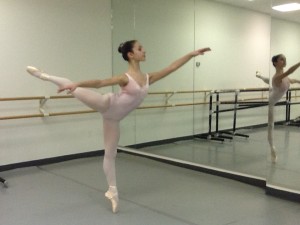Please welcome dancer Jorina Kardashi from Princeton Dance and Theater Studio for today’s student spotlight….

When I was younger, I always loved to dance all around the house. I started out taking some dance classes at a local YMCA at four years old, but the lessons weren’t the challenging classes that my parents were hoping for. Our neighbors had a daughter who did ballet, so they recommended the Princeton Dance and Theater Studio to my parents. Taking their advice, my mom and dad decided to enroll me at PDT, and I have been dancing there ever since.
2. What do you find you like best about dance class?
Between the two parts of ballet class, barre and center, I would have to say that center work is definitely more enjoyable. Especially during more “dancy” combinations, I can let go of everything and just have fun. The technique that I gain from barre carries through to the center and becomes my second nature, and not something that I need to focus on. The euphoria that I have for dance mainly comes from the feeling that washes over me every time that I start a combination in center and find myself lost in the steps, enjoying every minute of class.
3. What is the hardest part about dance for you?
One of the hardest things that I’ve had to do is to correct the occasional bad dance habit. I’ve found that if I learn something slightly incorrectly, that habit is embedded in my muscles and becomes part of my muscle memory. Once the habit is pointed out, I have to force myself to do it correctly and to think about it every second. I’ve realized that it’s extremely difficult to continue this process until the new memory is formed, but it is a vital skill to reach success.
4. What advice would you give to other dancers?
I would advise other dancers to try to expose themselves to as many different styles of dance as possible. When I have gone outside of my comfort zone, I’ve actually improved my dancing in my field of expertise, ballet. Recently while working on a contemporary piece I learned how to loosen up my body a little more, something that has carried through to my every day ballet classes. I completely understand that trying new styles is hard, but taking other classes has helped me fix many of my technical ballet corrections.
5. How has dance changed your life?
Dance has impacted my life in a way nothing else ever has. It has given me an outlet where I can hone in on one activity without having to worry about anything that is going on in school or with my academic work. It has given me a way to challenge myself and attempt to use my body in a way it isn’t normally used. Finally, it has given me a way to express myself and an appreciation for different art forms. Although it can be hard to fit dance into my schedule, it has become a defining characteristic for my personality and who I really am.













